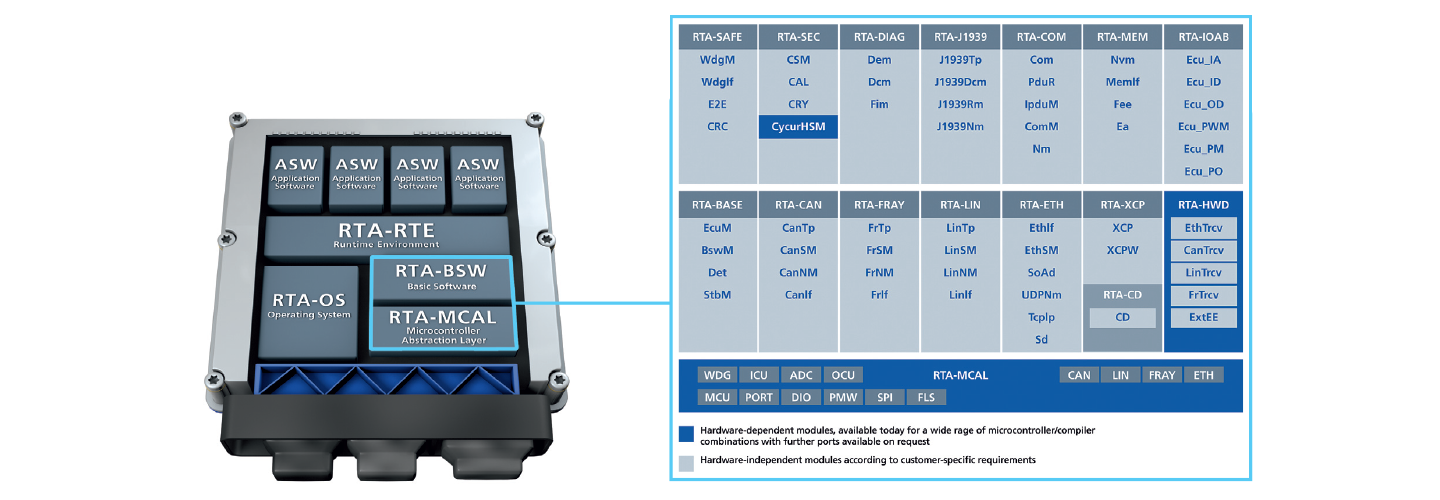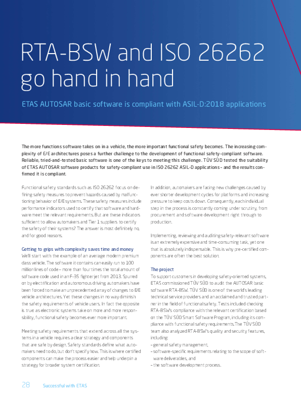RTA-BSW and ISO 26262 go hand in hand
ETAS AUTOSAR basic software is compliant with ASIL-D:2018 applications

The more functions software takes on in a vehicle, the more important functional safety becomes. The increasing complexity of E/E architectures poses a further challenge to the development of functional safety-compliant software. Reliable, tried-and-tested basic software is one of the keys to meeting this challenge. TÜV SÜD tested the suitability of ETAS AUTOSAR software products for safety-compliant use in ISO 26262 ASIL-D applications – and the results confirmed it is compliant.
Functional safety standards such as ISO 26262 focus on defining safety measures to prevent hazards caused by malfunctioning behavior of E/E systems. These safety measures include performance indicators used to certify that software and hardware meet the relevant requirements. But are these indicators sufficient to allow automakers and Tier 1 suppliers to certify the safety of their systems? The answer is most definitely no, and for good reasons.
Getting to grips with complexity saves time and money
We’ll start with the example of an average modern premium class vehicle. The software it contains can easily run to 100 million lines of code – more than four times the total amount of software code used in an F-35 fighter jet from 2013. Spurred on by electrification and autonomous driving, automakers have been forced to make an unprecedented array of changes to E/E vehicle architectures. Yet these changes in no way diminish the safety requirements of vehicle users. In fact the opposite is true: as electronic systems take on more and more responsibility, functional safety becomes ever more important.
Meeting safety requirements that extend across all the systems in a vehicle requires a clear strategy and components that are safe by design. Safety standards define what automakers need to do, but don’t specify how. This is where certified components can make the process easier and help underpin a strategy for broader system certification.
In addition, automakers are facing new challenges caused by ever shorter development cycles for platforms and increasing pressure to keep costs down. Consequently, each individual step in the process is constantly coming under scrutiny, from procurement and software development right through to production.
Implementing, reviewing and auditing safety-relevant software is an extremely expensive and time-consuming task, yet one that is absolutely indispensable. This is why pre-certified components are often the best solution.

What is RTA-BSW?
RTA-BSW is a production-ready AUTOSAR Classic basic software collection from ETAS that forms the core of the RTA Classic AUTOSAR product portfolio, called RTA-CAR. The software draws on over 20 years of experience of in-vehicle use with nearly 2 billion ECUs already on the road and zero post-production issues. RTA-BSW supports AUTOSAR R4.x functions and consists of a comprehensive set of AUTOSAR stacks (collections of modules) such as communication, memory, diagnostics, and safety. The modules of the basic software facilitate central ECU communication functions which are generally regarded as a common basis for the development of specific vehicle functions.
The project
To support customers in developing safety-oriented systems, ETAS commissioned TÜV SÜD to audit the AUTOSAR basic software RTA-BSW. TÜV SÜD is one of the world’s leading technical service providers and an acclaimed and trusted partner in the field of functional safety. Tests included checking RTA-BSW’s compliance with the relevant certification based on the TÜV SÜD Smart Software Program, including its compliance with functional safety requirements. The TÜV SÜD team also analyzed RTA-BSW’s quality and security features, including:
- general safety management,
- software-specific requirements relating to the scope of soft- ware deliverables, and
- the software development process.
The project drew on a number of different safety standards in order to cover passenger vehicles, motorbikes, trucks, and off-highway machines. The following safety standards were applied in the compliance assessment:
- ISO 26262:2018
- IEC 61508:2010
- ISO/DIS 19014:2018
- ISO 25119:2018
Overall, the assessment confirmed that RTA-BSW meets the relevant requirements of the TÜV SÜD Smart Software Program, including those contained in the functional safety module. This represents an important milestone for the ETAS RTA team in the UK, Germany, and Italy. Through RTA-BSW ETAS customers now have access to a solid basis for achieving high safety standards.
Summary
The automotive industry is currently facing numerous changes that affect each and every step in the automotive software development process. The effect of these changes is particularly noticeable in the field of safety-relevant embedded software. Confronted with an urgent need to make more savings, companies are being forced to focus on differentiating factors while relying on off-the-shelf components such as AUTOSAR platforms for other areas. By offering a range of certified AUTOSAR basic software products, ETAS helps customers meet the highest safety standards, ensuring that they are fully prepared for the challenges that lie ahead.
Authors
Luca Baldini is Product Manager for RTA-BSW at ETAS Ltd. in York, UK.
Daniele Garofalo is Global Head of Product Management RTA Solutions at ETAS Ltd. in York, UK.
Jonathan Manktelow is Safety Certification Project Manager at ETAS Ltd. in York, UK.
